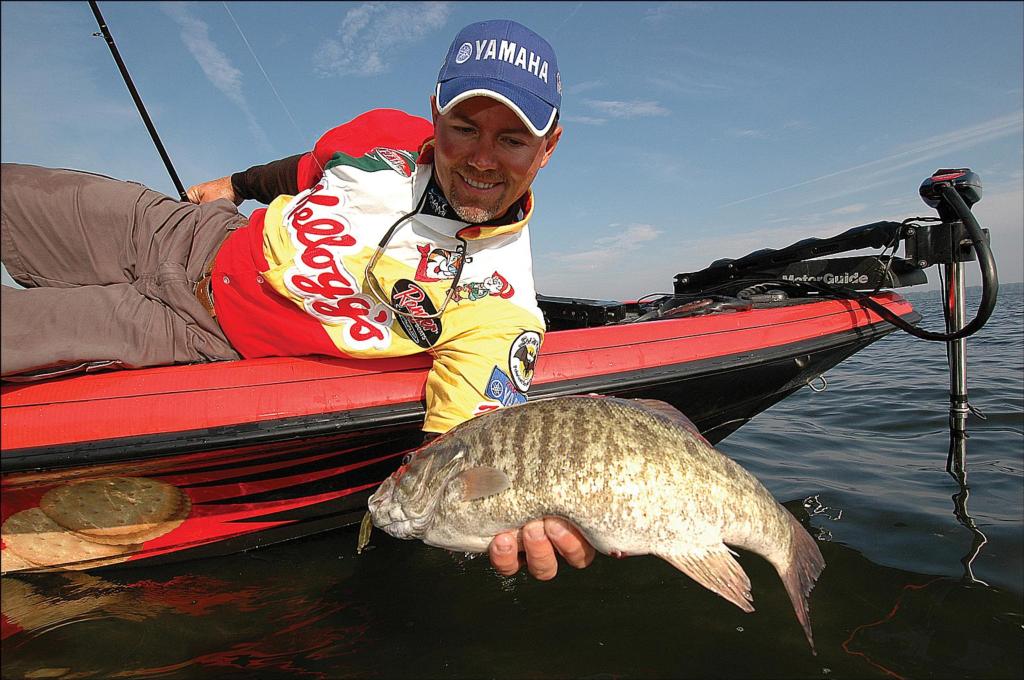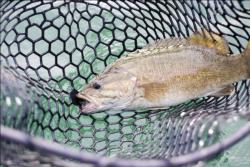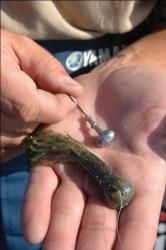Big-water smallmouths
Don’t be intimidated by vast expanses of water

————————————–
Editor’s note: This article originally appeared in the May-June 2006 Bass Edition issue of FLW Outdoors Magazine. Learn more about FLW Outdoors Magazine and how to subscribe by clicking here.
————————————–
Big-water smallmouth fishing intimidates on two levels: the size of the water and the size of the waves.
First, there’s the immensity of freshwater seas like Lake Erie and Lake St. Clair. Most tournaments on these vast waters are won by probing offshore smallmouth hangouts that can be seen only with a depth finder. Where do you begin to fish?
Then there’s the high potential for blustery winds and back-crunching waves that can quickly grow life-threatening. Pro Dave Lefebre of Union City, Pa., is well acquainted with harrowing boat rides. A regular on the Walmart FLW Tour, Lefebre claims Erie as his home lake.
As a teenager, Lefebre and his father frequently launched an old aluminum boat powered by a 40-horsepower outboard at Shades Beach, Pa. They didn’t have to travel far to catch bass. Straight out from Shades Beach are many offshore humps and drops that teem with smallmouths.
Here, Lefebre learned the rudiments of big-water smallmouth fishing and refined techniques that later helped him score big in local tournaments. When Lefebre was 17, he and his father located an offshore reef that continues to be especially reliable. Since this was before GPS units were common, he triangulated this spot, and many others, by lining up objects on shore. His grandparents’ house, which sits on a cliff there and overlooks the lake, is a common point of reference.
Though Lefebre says this entire stretch of water is a “community area,” his prime fishing holes receive little pressure. He believes this is because most fishermen lose perspective when they venture onto big water.
Shallow close to deep: “People forget to look for key, small locations when they fish big water like Erie,” Lefebre said. “But smallmouth bass are the same wherever they live. They gang up on little sweet spots. You have to find these places and focus your efforts on them.” What leads many anglers astray is the size of some of the bottom formations on big waters. Many reefs cover several hundred yards. When checking out a large bottom structure for the first time, Lefebre first scrutinizes it with the depth finder on his console. Then he fishes anything that looks promising to find where bass congregate. When money is on the line, he fishes these niches and ignores everything else.
“One thing I always look for is the shallowest water on a piece of structure closest to the deepest water,” Lefebre says.
His most productive drop at Shades Beach plummets from 12 feet on top of the hump to a depth of 23 feet. This is also the approximate depth range he concentrates on when fishing here from the prespawn through postspawn phases, and again in the fall. When bass move deeper during the hot months, Lefebre backs out to 30 to 40 feet of water and continues to concentrate on zones where the shallowest water lies closest to the deepest water.
Magic tube: Lefebre’s money bait is a 4-inch Mizmo tube stuffed with a 1/2- or 3/4-ounce football-head jig. Wrestling the fat jighead inside the bait results in a deformed, fat-headed tube that Lefebre calls “magic.”
“I think the football head makes the tube look more like a goby,” Lefebre says. “I use dark goby colors like brown or green pumpkin with green, black or gold flake.”
The round goby, a nonindigenous fish from the Black Sea, has flourished in many areas of the Great Lakes. These plump, slow-moving fish swarm hard bottom structures covered with zebra mussels, another invader from overseas. A goby swimming in front of a bass is like a Snickers bar dangling within reach of a hungry fisherman.
Long casts: Lefebre launches his heavy tube practically into orbit with a 7-foot, 11-inch, medium-action graphite baitcasting rod. He matches the rod with a high-speed reel and 10-pound fluorocarbon line. The long rod and high-speed reel eat up slack when Lefebre sets the hook on a distant bass. Are long casts truly necessary?

“It makes a big difference,” Lefebre emphasizes. “I like to get the bait as far away from the boat as I can. If you fish too close to the bass, your trolling motor and transducer noise makes them harder to catch.”
As Lefebre keeps his distance, he works a piece of structure from several different angles to milk as many bass from a given spot as possible. He swims the bait along and touches bottom after every lift. If you ever fish with him, you’ll grow accustomed to the sound of his long rod swishing through the air. He sets the hook hard with distracting frequency and comes up empty more often than not.
“Sometimes strikes are really hard to feel,” he says. “I believe in the old saying that hooksets are free.”
Many smallmouth anglers avoid bottom structures covered with a green, slimy growth that readily fouls tubes and other bottom baits. Lefebre believes the gunk actually attracts bigger bass and he happily deals with it. How does he keep his heavy tube from being constantly slimmed?
“I fish it the way you work a Rat-L-Trap in the grass,” Lefebre says. “I try to touch the top of the grass but not get bogged down in it. If the tube picks up some grass, I snap the rod to clean the bait off. A lot of times, that triggers a strike.”
Drifting is a drag: Windy weather usually turns on big-water smallmouths, but sometimes it overwhelms Lefebre’s electric motor. When this occurs, he reluctantly resorts to drifting and dragging a tube, which is what many competitors do when they fish for big-water smallmouths under any conditions.
The drift-and-drag consists of letting the wind push the boat over smallmouth structures while the anglers drag bottom baits behind the boat. Turning the outboard all the way to one side and setting out a drift sock from the bow cleat holds the boat broadside to the wind. The sock also slows the drift. When whitecaps get smallmouths snapping, it’s possible to drift for a half mile or more over a good area and randomly snatch bass throughout the drift.
“To me, drifting is not bass fishing,” Lefebre says. “I like casting to a specific target. But when the wind is over 15 mph, I have no choice but to drift.”
Lefebre continues to key on his sweet spots by making short drifts. This is where the chartplotter/sounders on his bow and console keep him on track. After idling upwind of a sweet spot, Lefebre sets his boat adrift where he believes the wind will push him over the bass. He turns his boat sideways by cutting his outboard and nudging the bow around with his electric motor. He prefers not to use a drift sock.
“I don’t drift blind like everybody else does, but it’s hard to know exactly where the wind will push the boat,” Lefebre said. “Each time I make a drift, it leaves a path on my chartplotters. Those paths help me make whatever adjustments are needed to hit my spots. That’s vital.”
As when casting, Lefebre maintains a long distance between him and his bait to avoid putting off the bass. He estimates that his tube is normally dragging on bottom two long casts behind the boat.
Casting and drifting produced smallmouth bass for Lefebre when he fished a Stren Series tournament in July 2003 on the Detroit River. He fished along the Canadian shore of Lake Erie during practice and found a half-dozen key spots 18 to 20 feet deep on a hump that measured roughly 300 by 600 yards.
Lake Erie lay flat the first two days of the tournament, and Lefebre’s 10 bass that weighed 34 pounds, 12 ounces made him the No. 1 qualifier for the finals. The wind blew hard the final two days and Lefebre had to drift. He managed to land enough bass to finish in fourth place but is convinced he would have won the event had the weather stayed calm enough for him to continue casting his magic tube.
Drop-shot
Lefebre occasionally fishes a 1/2-ounce drop-shot rig with an 8-inch drop line, an Owner Mosquito hook and a 2 3/4-inch Mizmo Bass Snack tube. He lightly hooks the tube through the nose and casts and retrieves the rig just as he does when fishing a tube. He also fishes the drop-shot rig vertically.

“A lot of the biggest smallmouths I catch are ones that I mark just off a piece of structure,” Lefebre says. “These are individual fish I see on my graph at the end of a drift or while I’m casting. I let the drop-shot rig drop straight down on their noses and catch them.”
Tube stuffing
Cramming a 1/2- or 3/4-ounce jig into a tube is an aggravating chore. Coating the jighead and the tube’s opening with spit helps. Lubricating the jig and tube with an oil-base scent works even better. Rather than waste time stuffing tubes on the water, rig the baits at home before leaving for a tournament. At home you can warm the tubes in an oven set on low heat. This makes the plastic more flexible and receptive to the jig.